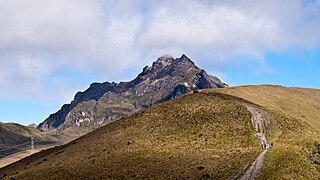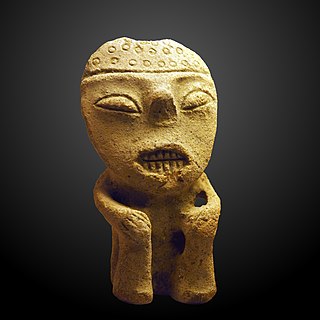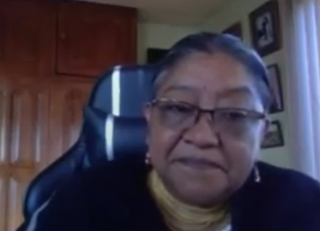
The Napo River is a tributary to the Amazon River that rises in Ecuador on the flanks of the east Andean volcanoes of Antisana, Sincholagua and Cotopaxi.

Pichincha is a stratovolcano in Ecuador. The capital Quito wraps around its eastern slopes.

El Altar or Capac Urcu is an extinct volcano on the western side of Sangay National Park in Ecuador, 170 km (110 mi) south of Quito, with a highest point of 5,319 m (17,451 ft). Spaniards named it so because it resembled two nuns and four friars listening to a bishop around a church altar. In older English sources it is also called The Altar.

Communal work is a gathering for mutually accomplishing a task or for communal fundraising. Communal work provided manual labour to others, especially for major projects such as barn raising, "bees" of various kinds, log rolling, and subbotniks. Different words have been used to describe such gatherings.

The Chullachaki or Chullachaqui, also known as the Shapishico, is a mythical forest creature of the Peruvian and Brazilian Amazonian jungle.

Kichwa is a Quechuan language that includes all Quechua varieties of Ecuador and Colombia (Inga), as well as extensions into Peru. It has an estimated half million speakers.

Media Lengua, also known as Chaupi-shimiChaupi-lengua, Chaupi-Quichua, Quichuañol, Chapu-shimi or llanga-shimi, is a mixed language with Spanish vocabulary and Kichwa grammar, most conspicuously in its morphology. In terms of vocabulary, almost all lexemes (89%), including core vocabulary, are of Spanish origin and appear to conform to Kichwa phonotactics. Media Lengua is one of the few widely acknowledged examples of a "bilingual mixed language" in both the conventional and narrow linguistic sense because of its split between roots and suffixes. Such extreme and systematic borrowing is only rarely attested, and Media Lengua is not typically described as a variety of either Kichwa or Spanish. Arends et al., list two languages subsumed under the name Media Lengua: Salcedo Media Lengua and Media Lengua of Saraguro. The northern variety of Media Lengua, found in the province of Imbabura, is commonly referred to as Imbabura Media Lengua and more specifically, the dialect varieties within the province are known as Pijal Media Lengua and Angla Media Lengua.
Píntag is an agrarian village located 27.5 kilometers southeast of Quito in Pichincha Province, Ecuador.
Paccha is a town and parish in Cuenca Canton, Azuay Province, Ecuador. The parish covers an area of 25.6 km2 and according to the 2001 Ecuadorian census it had a population total of 5,311.
Amazonian Kichwas are a grouping of indigenous Kichwa peoples in the Ecuadorian Amazon, with minor groups across the borders of Colombia and Peru. Amazonian Kichwas consists of different ethnic peoples, including Napo Kichwa and Canelos Kichwa. There are approximately 419 organized communities of the Amazonian Kichwas. The basic socio-political unit is the ayllu. The ayllus in turn constitute territorial clans, based on common ancestry. Unlike other subgroups, the Napo Kichwa maintain less ethnic duality of acculturated natives or Christians.

Nina Pacari, born as María Estela Vega Conejo is a Kichwa politician, lawyer and indigenous leader from Ecuador.
The 2014 Campeonato Ecuatoriano de Fútbol de la Serie A was the 56th season of the Serie A, Ecuador's premier football league.
Huasipungo is a 1934 novel by Jorge Icaza (1906-1978) of Ecuador.
Liga Deportiva Universitaria de Quito's 2014 season was the club's 84th year of existence, the 61st year in professional football, and the 53rd in the top level of professional football in Ecuador.

Cutimbo is an archaeological site with stone tombs (chullpa) and cave paintings in Peru.
Runa Foundation is a public, non-profit organization with offices in Brooklyn, NY; Quito, Ecuador; Archidona, Ecuador; and Tarapoto, Peru. Runa Foundation's stated mission is to "create new value for tropical forests that benefit local people and the forest ecosystem". Runa Foundation is a 501(c)3 non-profit corporation registered in the state of Rhode Island.
The 2018 Campeonato Ecuatoriano de Fútbol Serie A was the 60th season of the Serie A, Ecuador's top tier football league. Emelec were the defending champions. First stage winners LDU Quito defeated second stage winners and defending champions Emelec 2–1 on aggregate in the final to win their eleventh domestic title.
The 2020 Campeonato Ecuatoriano de Fútbol Serie A was the 62nd season of the Serie A, Ecuador's top tier football league, and the second under the management of the Liga Profesional de Fútbol del Ecuador. Delfín were the defending champions. Barcelona won their 16th domestic league title after defeating LDU Quito 3–1 on penalties following a 1–1 draw on aggregate score in the finals.
The 2022 Copa Ecuador was the second edition of the Copa Ecuador, Ecuador's domestic football cup. It began on 6 May 2022 and ended with the single-legged final on 8 November 2022.









